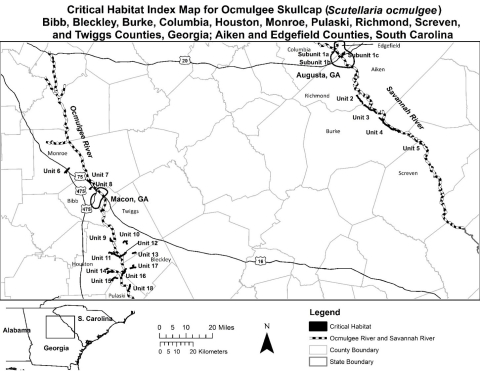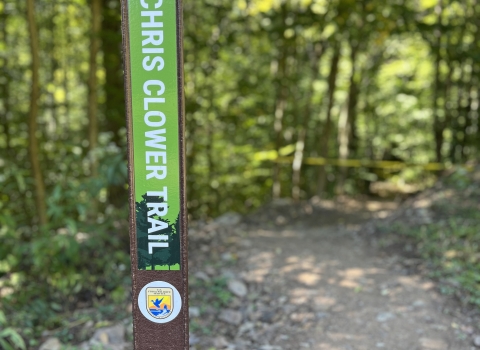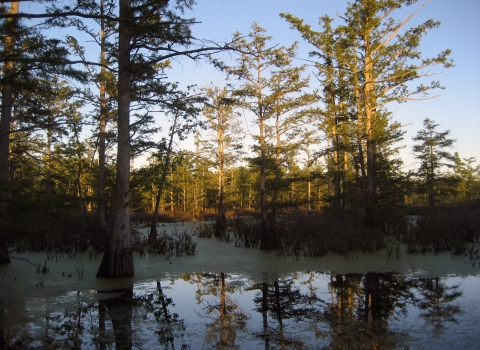What is the Ocmulgee skullcap and where does it occur?
The Ocmulgee skullcap is a rare plant in the mint family. It can only be found on bluffs and steep slopes in the Savannah River and Ocmulgee River watersheds.
What action is the U.S. Fish and Wildlife Service taking?
The U.S. Fish and Wildlife Service is proposing to list Ocmulgee skullcap as threatened under the Endangered Species Act (ESA) with a section 4(d) rule. The section 4(d) rule would allow for activities that would not harm the plant while still providing protection. The Service is also proposing to designate 6,577 acres as critical habitat for the plant in Georgia and South Carolina.
Why is the Service proposing to list the Ocmulgee skullcap as a threatened species?
The ESA defines an endangered species as one that is “in danger of extinction throughout all or a significant portion of its range” and a threatened species as one that is “likely to become an endangered species within the foreseeable future throughout all or a significant portion of its range.”
Based on the best available science, the Service has determined that the Ocmulgee skullcap meets the definition of a threatened species. Currently, there are 19 remaining populations in two units: the Ocmulgee River watershed in Georgia (13 populations) and the Savannah River watershed in Georgia/South Carolina (six populations). Two occurrences of Ocmulgee skullcap within the Savannah River watershed have disappeared since 1999. Remaining populations of the plant are generally small; three remaining populations contain 50 or more individuals and 14 have fewer than 20 individuals. Primary threats to the Ocmulgee skullcap’s current and future condition are habitat loss and fragmentation due to development and urbanization, competition from nonnative invasive species invasive species
An invasive species is any plant or animal that has spread or been introduced into a new area where they are, or could, cause harm to the environment, economy, or human, animal, or plant health. Their unwelcome presence can destroy ecosystems and cost millions of dollars.
Learn more about invasive species , herbivory from white-tailed deer, and the effects of a changing climate.
How does the ESA define critical habitat?
The ESA defines critical habitat as the specific geographic areas that contain features essential to the conservation of an endangered or threatened species that may require special management and protection. Critical habitat may also include areas that are not currently occupied by the species but will be needed for its recovery.
How does the Service determine what areas to designate as critical habitat?
Within areas occupied by the species, biologists consider physical or biological features needed for life processes. After considering occupied areas, biologists consider unoccupied areas that may be essential for the conservation of the species. These include:
Space for individual and population growth and for normal behavior;
Cover or shelter;
Food, water, air, light, minerals, or other nutritional or physiological requirements;
Sites for breeding and rearing offspring; and
Habitats that are protected from disturbances or are representative of the historical, geographical, and ecological distributions of a species.
What is the proposed critical habitat designation for the Ocmulgee skullcap?
The Service is proposing to designate 6,577 acres of critical habitat in 18 units. The proposed units fall within 10 counties in Georgia (Bibb, Bleckley, Burke, Columbia, Houston, Monroe, Pulaski Pulaski
The Pulaski is a special hand tool used in wildland firefighting. The tool combines an axe and an adze in one head, similar to that of the cutter mattock, with a rigid handle of wood, plastic, or fiberglass. The Pulaski is a versatile tool for constructing firebreaks, as it can be used to both dig soil and chop wood.
Learn more about Pulaski , Richmond, Screven, and Twiggs counties) and two counties in South Carolina (Aiken and Edgefield counties). Critical habitat units include current Ocmulgee skullcap occurrences and suitable habitat within a 1.2 mile buffer required to support the species’ pollinators and provide a buffer to reduce nonnative vegetation encroachment. Of this proposed acreage, 14 percent is state-owned lands, nine percent is state-leased and managed lands, and 85 percent is privately owned lands (including state-leased lands). The Service has exempted 224 acres on Robins Air Force Base from the proposed critical habitat since it is covered by an Integrated Natural Resources Management Plan (INRMP) that provides for Ocmulgee skullcap conservation.
Critical habitat index map for Ocmulgee skullcap
Are there any other threatened or endangered species that grow where Ocmulgee skullcap occurs?
Ocmulgee skullcap co-occurs on several sites with the endangered plant, relict trillium.
What is a 4(d) rule? Why is this being proposed for the Ocmulgee skullcap?
For threatened species, the Service uses the flexibility provided under section 4(d) of the ESA to tailor take prohibitions for the conservation of the species. This targeted approach helps reduce regulatory burdens by exempting certain activities that do not significantly harm the species, or that are beneficial, while focusing conservation efforts on the threats detrimental to recovery.
The Service has developed a proposed 4(d) rule that is designed to address the Ocmulgee skullcap’s specific threats and conservation needs. The proposed 4(d) rule would promote conservation of the Ocmulgee skullcap by encouraging management of the landscape in ways that meet both land management considerations and the conservation needs of the Ocmulgee skullcap. The provisions of this proposed rule are one of many tools that the Service will use to promote the conservation of Ocmulgee skullcap, should it become listed as a threatened species.
How do I submit comments on this proposal?
To submit comments on the proposed rule, go to the Federal eRulemaking Portal: http://www.regulations.gov. In the Search box, enter FWS–R4–ES–2021–0059, which is the docket number for this rulemaking. Comments on the proposed rule must be received by August 22, 2022. We must receive requests for public hearings, in writing, at the address shown in FOR FURTHER INFORMATION CONTACT by August 8, 2022.
You may submit comments by one of the following methods:
(1) Electronically: Go to the Federal eRulemaking Portal:
https://www.regulations.gov. In the Search box, enter the docket number for this rulemaking (FWS-R4-ES-2021-0059). For best results, do not copy and paste either number; instead, type the docket number into the Search box using hyphens. Then, click on the Search button. On the resulting page, in the panel on the left side of the screen, under the Document Type heading, check the Proposed Rule box to locate this document. You may submit a comment by clicking on “Comment.”
(2) By hard copy: Submit by U.S. mail to: Public Comments Processing, Attn: FWS-R4-ES-2021-0059, U.S. Fish and Wildlife Service, MS: PRB/3W, 5275 Leesburg Pike, Falls Church, VA 22041–3803.
We request that you send comments only by the methods described above. We will post all comments on http://www.regulations.gov. This generally means that we will post any personal information you provide us.
Availability of supporting materials: For the critical habitat designation, the coordinates or plot points or both from which the maps are generated are included in the decision file and are available at https://www.regulations.gov under Docket No. FWS-R4-ES-2021-0059 and on the Service’s website, at https://www.fws.gov/office/georgia-ecological-services/library. Additional supporting information that we developed for this critical habitat designation will also be available on the Service’s website, at https://www.regulations.gov, or both.
FOR FURTHER INFORMATION CONTACT: Peter Maholland, Acting Field Supervisor, U.S. Fish and Wildlife Service, Georgia Ecological Services Field Office, 355 East Hancock Avenue, Room 320, Athens, Georgia 30601; telephone 706-613-6059. Individuals in the United States who are deaf, deafblind, hard of hearing, or have a speech disability may dial 711 (TTY, TDD, or TeleBraille) to access telecommunications relay services. Individuals outside the United States should use the relay services offered within their country to make international calls to the point-of-contact in the United States.



